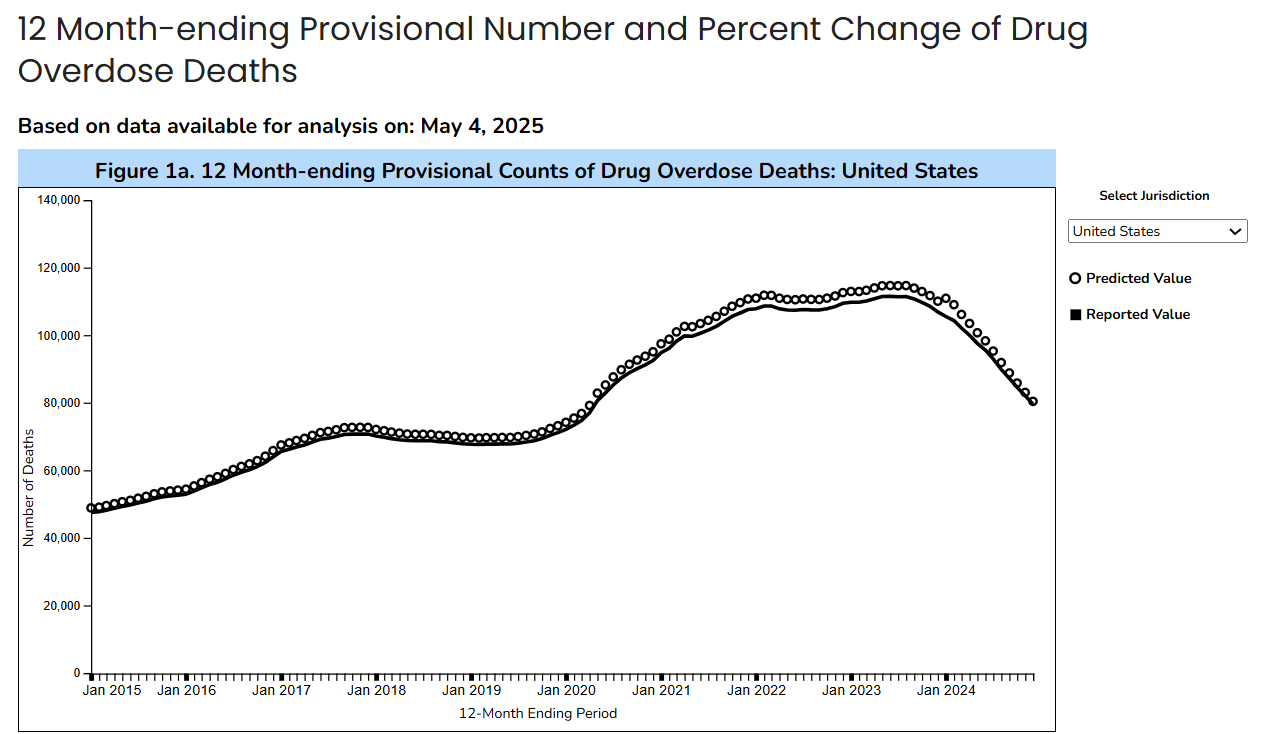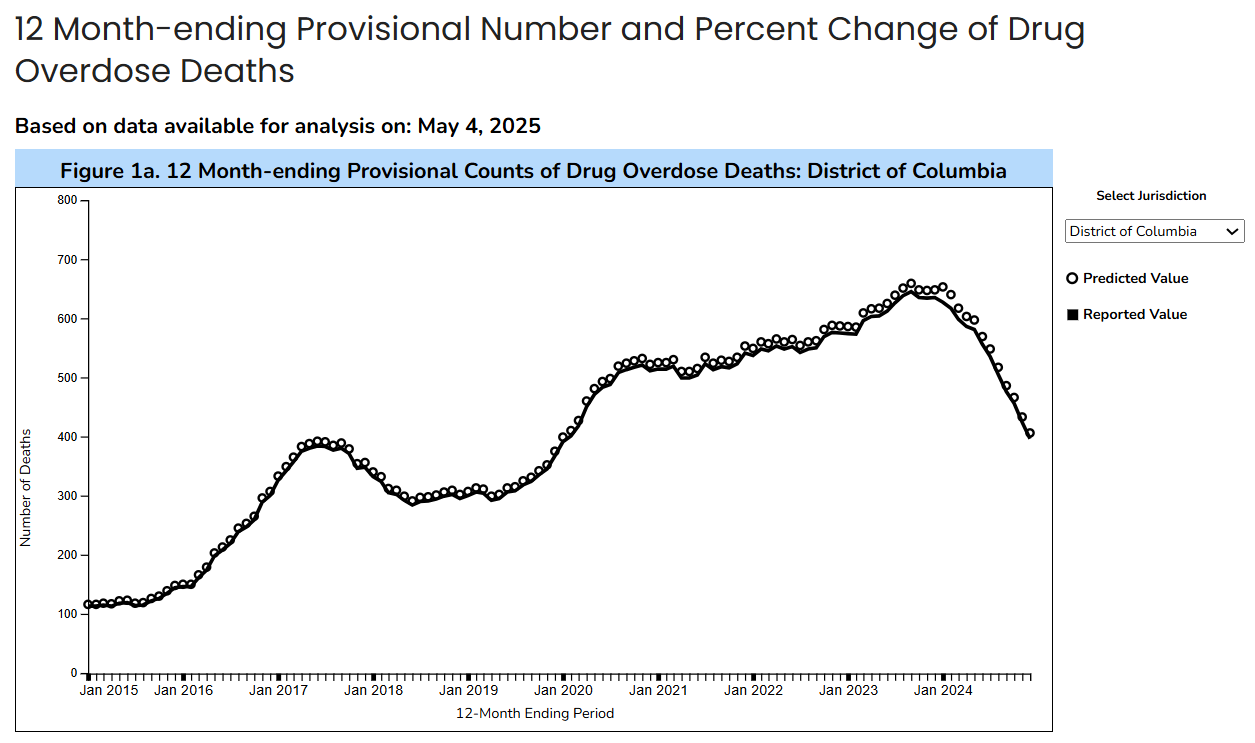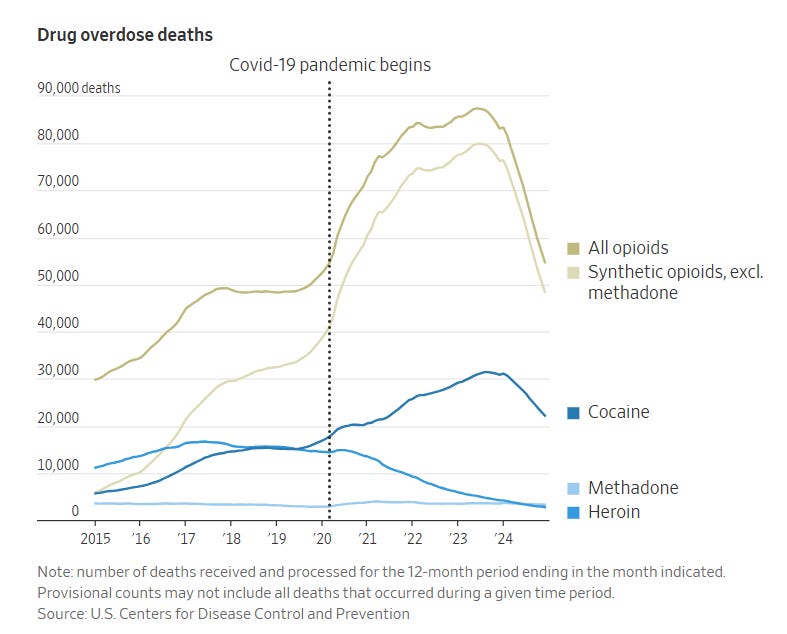Good News: U.S. Drug Overdose Deaths Decrease Over 25% in 2024, Estimated
Continues the good trend announced earlier in the year...but what is driving this?
14 May 2025, CDC: U.S. Overdose Deaths Decrease Almost 27% in 2024
Provisional data from the CDC’s National Center for Health Statistics indicate there were an estimated 80,391 drug overdose deaths in the United States during 2024—a decrease of 26.9% from the 110,037 deaths estimated in 2023.
Annual drug overdose deaths are projected to reach their lowest level since 2019.
Almost all states across the nation saw decreases; Louisiana, Michigan, New Hampshire, Ohio, Virginia, West Virginia, and Wisconsin and Washington, D.C., experienced declines of 35% or more. In contrast, South Dakota and Nevada had slight increases compared to the same period in 2023.
The new data show overdose deaths involving opioids decreased from an estimated 83,140 in 2023 to 54,743 in 2024. Overdose deaths involving cocaine and psychostimulants (like methamphetamine) decreased as well.
Huge decreases, which is great. Some of this is estimates, but a great deal of this is based on deaths already reported.
As I wrote in February of this year, there was already an indication of the trend turning around. I mentioned that the trend actually was turning around in 2023, in terms of rate, which may have been related to pandemic effects decreasing. But, due to the very strange patterns I’m seeing across the states, I wonder if something else entirely is going on.
I will get back to this at the end of the post.
Visualization of Drug OD deaths: United States
CDC: Provisional Drug Overdose Death Counts
On this page, there are interactive charts showing a moving 12-month count of drug OD deaths.
Let me show the default U.S.-level chart:
The time series here shows time steps of month-by-month, but each circle (which is the estimated total) and the line (which has been reported thus far) represent 12 months of deaths ending in the month being plotted.
This is like a moving average plot, so it does not represent the number of drug OD deaths occurring in that month.
That said, it gives you an idea of how drug OD deaths are trending over time, in an annualized way, so it is a useful way to plot this data.
I also checked out the footnotes on why there is a gap between “predicted value” and “reported value” from 3 years ago.
Drug overdose deaths often require lengthy investigations, and death certificates may be initially filed with a manner of death “pending investigation” and/or with a preliminary or unknown cause of death. When the percentage of records reported as “pending investigation” is high for a given jurisdiction, the number of drug overdose deaths is likely to be underestimated. For jurisdictions reporting fewer than 1% of records as “pending investigation”, the provisional number of drug overdose deaths occurring in the fourth quarter of 2015 was approximately 5% lower than the final count of drug overdose deaths occurring in that same time period. For jurisdictions reporting greater than 1% of records as “pending investigation” the provisional counts of drug overdose deaths may underestimate the final count of drug overdose deaths by as much as 30%. Thus, jurisdictions are included in Figure 2 if 1% or fewer of their records in NVSS are reported as “pending investigation” for six consecutive 12-month ending periods. For jurisdictions not meeting quality measures for all periods starting with January 2015, predicted values are shown for all data points that meet percent completeness and drug specificity thresholds with reported values only shown for months where all three data quality measures were met. As a result, there may be gaps in the trends if data quality thresholds are met for some time periods and not others. Values for records pending investigation are updated with each monthly release and reflect the most current data available.
“Figure 2” has to do with the type of drug involved in the OD. The issue is that there are some jurisdictions with persistent data quality issues, so those gaps will persist. Oh well.
I saw there was a discontinuity in their estimate in January 2024, as well. They actually provided their completeness assumptions by jurisdiction, which is interesting. I will be selecting a few jurisdictions to display below, because there is something real going on. But what is it?
Map of Effect by State, 12 Months Ending December 2024
I am not happy with their color scale choice (did y’all check for colorblind-friendly?), but I can at least see some notable locations: it got worse in Nevada and South Dakota, got a lot better in the Virginias and Louisiana, and I might want to select from a few other places.
We will keep in mind that some of the places, like Iowa, may not have gotten much better for some very reasonable situations.
Nevada
This is not a great trend, but this may reflect Nevada (or, rather, Las Vegas) recovering from pandemic depression.
First, I want to note there was barely any growth in drug OD death counts pre-pandemic, compared to the relatively large increase during 2020 and 2021 (you will see this pattern across multiple states)… but then it flattened off in 2022, and then post-pandemic it grew again… maybe the tourists and convention traffic was back?
South Dakota
In general, using the 12-month ending time series smooths out results, but South Dakota has such a small population and small number of drug OD deaths (the other states have thousands of ODs) that it’s very noisy in results.
It’s difficult to read a trend — the count may be slightly up, but the rate compared to its population could be down.
Virginia
Virginia is a large state with a large population, and an unfortunate large number of drug OD deaths, which also gives a smooth profile.
There is some increase before the pandemic, very large increases in 2020-2021, a plateau over 2022 and early 2023, and then a large decrease in 2024 down to almost 2019 levels.
West Virginia
There is a difference in the shape between West Virginia and Virginia — there was a small peak pre-pandemic. You can see this in the U.S.-level numbers, too — there had been something of a retreat before the large increase in the initial pandemic years.
Washington, DC
That “hump” of pre-pandemic drug OD deaths, and then retreat, in 2017-2018, is more pronounced in DC.
I wondered what that was about. I don’t think that was a reduction in supply (but maybe it was), but interventions like Narcan as a result. I don’t think people reduced their usage.
New York City
This one is interesting in that there is no “post-pandemic” plateau — just a change in slope from pre-pandemic to pandemic era… until WHOOPS we’re not doing this drug OD death thing anymore…. which is very odd.
Pandemic and Post-pandemic effects? GLP-1?
15 May 2025: Fatal Overdoses Fall to Prepandemic Levels
The U.S. has long struggled to slow the acceleration of drug-overdose deaths fueled by the opioid crisis. It is possible certain policy changes across states and communities have helped, including the increased distribution of the overdose-reversing drug naloxone. Telemedicine and mobile clinics have also made treatment more accessible to some rural communities.
“This progress is encouraging, but it’s fragile,” said Alexandria Macmadu, an assistant professor of epidemiology at Brown University’s School of Public Health. “We can’t mistake this progress for victory. Sustained investment is essential if we want to build on this momentum instead of backsliding.”
I think it may have been community interventions that helped in 2018-2019. Do you see the magnitude that was? [squint]
But here’s the deal: notice the very large decrease in cocaine overdose deaths?
Naloxone (aka Narcan) does not work with cocaine ODs. It’s for opioid overdoses.
Heroin ODs decreased over a long period, probably because people are using opioids instead. That’s displacement. Cocaine is a different sort of drug.
I think something is working in the case of both cocaine and opioids, leading to the rapid drop-off.
First possibility: there was a large increase in ODs because people were using more of their favored drugs in response to stress related to pandemic (or boredom from lockdowns, or they were using same amount of drugs but nobody was around to save them when they ODed.)
Those stressors let up in 2023 somewhat, and let up in a big way in 2024.
Note that it’s not just drug ODs that are related here, but also alcohol-related deaths for the same reason.
Second possibility: [not exclusive of the first] GLP-1 receptor agonists like semaglutide
You may be going: huh?
However, it seems these drugs, which many have used to control Type 2 diabetes and weight, have had effects on substance abuse disorders.
The role of glucagon‐like peptide 1 (GLP‐1) in addictive disorders
Br J Pharmacol. 2022 Feb 2;179(4):625–641. doi:10.1111/bph.15677
Abstract:
Drug, alcohol and tobacco use disorders are a global burden affecting millions of people. Despite decades of research, treatment options are sparse or missing, and relapse rates are high. Glucagon‐like peptide 1 (GLP‐1) is released in the small intestine, promotes blood glucose homeostasis, slows gastric emptying and reduces appetite. GLP‐1 receptor agonists approved for treating Type 2 diabetes mellitus and obesity have received attention as a potential anti‐addiction treatment. Studies in rodents and non‐human primates have demonstrated a reduction in intake of alcohol and drugs of abuse, and clinical trials have been initiated to investigate whether the preclinical findings can be translated to patients. This review will give an overview of current findings and discuss the possible mechanisms of action. We suggest that effects of GLP‐1 in alcohol and substance use disorders is mediated centrally, at least partly through dopamine signalling, but precise mechanisms are still to be uncovered.
There have been a lot of people using the new drugs for weight loss… perhaps this has led them to stop using opioids, cocaine, alcohol, and smoking?
That would be fabulous, if so!
It can be a combination of all these factors leading to such a huge drop-off in deaths, as well as government interception of supplies of opioids and cocaine (which I didn’t list above).
But while this is a large decrease, it is still after years of increases that had been large — 2019 levels were still very high. There is a long way to go.













One friend commenting on facebook thought that perhaps the supply was being diluted due to increasing costs (that darn inflation!) so I went looking for something like that....
.... but then while searching for something there, I came across this:
https://www.brookings.edu/articles/the-fentanyl-crisis-from-naloxone-to-tariffs/
"since the start of 2024, China has become more active in suppressing the flow of precursor chemicals, and Mexican cartels, perhaps purposefully, are now trafficking a less lethal version of fentanyl."
Ah, perhaps the dealers are finally learning how not to kill the customers. What an idea!
Can't tell you how *shocked* I am by New York City! 🤣